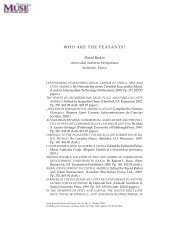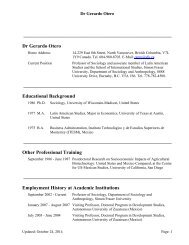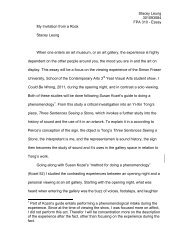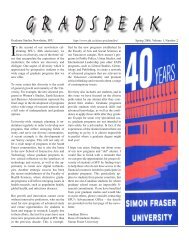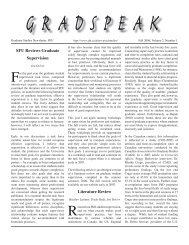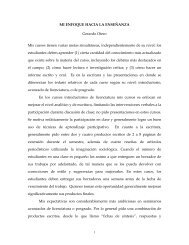Link - Simon Fraser University
Link - Simon Fraser University
Link - Simon Fraser University
You also want an ePaper? Increase the reach of your titles
YUMPU automatically turns print PDFs into web optimized ePapers that Google loves.
658 M. W. Hart and P. B. Markocomparative genomics has been the development ofsecond-generation sequencing technology. In largepart at the urging of developmental geneticists, thishigh-throughput sequencing capacity has led to thesequencing of hundreds of complete eukaryotic genomes.In addition to providing information foranalysis of gene expression patterns (for comparativedevelopmental biology), these new complete genomesequences can provide initial insight into genomes ofnonmodel organisms that present interesting phylogeographicproblems, and can be used for the designof sampling strategies for phylogeographic studiesbased on PCR amplification of known target lociand high-throughput sequencing of PCR amplicons.In addition, these complete genome sequences can alsoserve as reference sequences for the computationalassembly of whole genome sequence data from individualorganisms in phylogeographic studies. Thesetwo complementary approaches to using secondgenerationsequencing in phylogeographic studieshave different design requirements and might havedifferent goals, but both approaches seem to holdconsiderable promise for fully exploiting the new analyticalmethods and for resolving some of the mostimportant problems in larval ecology: how far dolarvae go, how often, and for how long have theydone so?AcknowledgmentsThanks to Jason Addison, David Ayre, Maria Byrne,Rick Grosberg, Jody Hey, Carson Keever, TammyMcGovern, Cecile Perrin, Jon Puritz, Jenn Sunday,and (especially) April Blakeslee for sharing data,analyses, and ideas used in this article.FundingPart of this work was carried out by using the resourcesof the Computational Biology Service Unitfrom Cornell <strong>University</strong>, which is partially funded byMicrosoft Corporation. We were supported by SICB,the Divisions of Invertebrate Zoology and of Ecologyand Evolution, American Microscopical Society,US National Science Foundation (OCE-0550526),and Natural Sciences and Engineering ResearchCouncil of Canada. This is Technical ContributionNo. 5822 of the Clemson <strong>University</strong> ExperimentStation, supported by the CSREES/USDA.ReferencesArndt A, Smith MJ. 1998. Genetic diversity and populationstructure in two species of sea cucumber: differing patternsaccording to mode of development. Mol Ecol 7:1053–64.Ayre DJ, Minchinton TE, Perrin C. 2009. Does life historypredict past and current connectivity for rocky intertidalinvertebrates across a marine biogeographic barrier? MolEcol 18:1887–903.Banks SC, Piggott MP, Williamson JE, Bové U, Holbrook NJ,Beheregaray LB. 2007. Oceanic variability and coastal topographyshape genetic structure in a lopng-dispersing seaurchin. Ecology 88:3055–64.Barber PH, Palumbi SR, Erdmann MV, Moosa MK. 2000.Biogeography. A marine Wallace’s line? Nature 406:692–3.Becquet C, Przeworski M. 2007. A new approach to estimateparameters of speciation models with application to apes.Genome Res 17:1505–19.Beerli P. 2004. Effect of unsampled populations on theestimation of population sizes and migration rates betweensampled populations. Mol Ecol 13:827–36.Beerli P, Felsenstein J. 1999. Maximum-likelihood estimationof migration rates and effective population numbers in twopopulations using a coalescent approach. Genetics 152:763–73.Beerli P, Felsenstein J. 2001. Maximum likelihood estimationof a migration matrix and effective population sizes in nsubpopulations by using a coalescent approach. Proc NatlAcad Sci USA 98:4563–8.Berger E. 1973. Gene-enzyme variation in three sympatricspecies of Littorina. Biol Bull 145:83–90.Berger E. 1977. Gene-enzyme variation in three sympatricspeceis of Littorina. II. The Roscoff population, with anote on the origin of North American L. littorea. BiolBull 152:255–64.Blakeslee AM, Byers JE, Lesser MP. 2008. Solving cryptogenichistories using host and parasite molecular genetics: theresolution of Littorina littorea’s North American origin.Mol Ecol 17:3684–96.Bohonak AJ. 1999. Dispersal, gene flow, and population structure.Quart Rev Biol 74:21–45.Bossart JL, Prowell DP. 1998. Genetic estimates of populationstructure and gene flow: limitations, lessons and new directions.Trends Ecol Evol 13:202–6.Brown CA, Jackson GA, Brooks DA. 2000. Particle transportthrough a narrow tidal inlet due to tidal forcing and implicationsfor larval transport. J Geophys Res 105:24141–56.Buonaccorsi VP, Kimbrell CA, Lynn EA, Vetter RD. 2002.Population structure of copper rockfish (Sebastes caurinus)reflects postglacial colonization and contemporary patternsof larval dispersal. Can J Fish Aquat Sci 59:1374–84.Burton RS. 1983. Protein polymorphisms and genetic differentiationof marine invertebrate populations. Mar Biol Lett4:193–206.Burton RS, Feldman MS. 1981. Population genetics ofTigriopus californicus: II. Differentiation among neighboringpopulations. Evolution 35:1192–205.Burton RS, Feldman MS. 1982. Population genetics of coastaland estuarine invertebrates: does larval behavior influencepopulation structure? In: Kennedy VS, editor. Estuarinecomparisons. New York: Academic Press. p. 537–51.Downloaded from icb.oxfordjournals.org at <strong>Simon</strong> <strong>Fraser</strong> <strong>University</strong> on November 2, 2010



